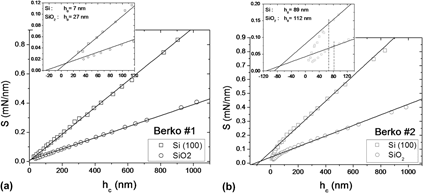Crossref Citations
This article has been cited by the following publications. This list is generated based on data provided by
Crossref.
Monclús, Miguel Alberto
Lotfian, Saeid
and
Molina-Aldareguía, Jon Mikel
2014.
Tip shape effect on hot nanoindentation hardness and modulus measurements.
International Journal of Precision Engineering and Manufacturing,
Vol. 15,
Issue. 8,
p.
1513.
Čech, Jaroslav
Haušild, Petr
Kovářík, Ondřej
and
Materna, Aleš
2016.
Examination of Berkovich indenter tip bluntness.
Materials & Design,
Vol. 109,
Issue. ,
p.
347.
Zong, W.J.
Wu, D.
and
Li, Z.Q.
2016.
Strength dependent design method for the crystal orientation of diamond Berkovich indenter.
Materials & Design,
Vol. 89,
Issue. ,
p.
1057.
Zong, W.J.
Wu, D.
and
He, C.L.
2017.
Radius and angle determination of diamond Berkovich indenter.
Measurement,
Vol. 104,
Issue. ,
p.
243.
Roldán, Marcelo
Fernández, Pilar
Rams, Joaquín
Sánchez, Fernando José
and
Gómez-Herrero, Adrián
2018.
Nanoindentation and TEM to Study the Cavity Fate after Post-Irradiation Annealing of He Implanted EUROFER97 and EU-ODS EUROFER.
Micromachines,
Vol. 9,
Issue. 12,
p.
633.
Yuanyuan, CUI
Ming, YE
Feng, Zhang
and
Jiping, Liu
2020.
A method of measuring the arc radius of Rockwell diamond indenter.
IOP Conference Series: Materials Science and Engineering,
Vol. 784,
Issue. 1,
p.
012011.
Sanchez-Camargo, Cesar-Moises
Hor, Anis
and
Mabru, Catherine
2020.
A robust inverse analysis method for elastoplastic behavior identification using the true geometry modeling of Berkovich indenter.
International Journal of Mechanical Sciences,
Vol. 171,
Issue. ,
p.
105370.
Roldán, M.
Fernández, P.
Rams, J.
Gómez-Herrero, A.
and
Malo, M.
2020.
Cavity formation and hardness change in He implanted EUROFER97 and EU-ODS EUROFER.
Nuclear Materials and Energy,
Vol. 22,
Issue. ,
p.
100717.
Rauter, Natalie
2021.
A computational modeling approach based on random fields for short fiber-reinforced composites with experimental verification by nanoindentation and tensile tests.
Computational Mechanics,
Vol. 67,
Issue. 2,
p.
699.
Rauter, Natalie
and
Lammering, Rolf
2021.
Experimental Characterization of Short Fiber-Reinforced Composites on the Mesoscale by Indentation Tests.
Applied Composite Materials,
Vol. 28,
Issue. 5,
p.
1747.
Nohava, Jiri
Čech, Jaroslav
Havlíček, Marek
and
Consiglio, Richard
2021.
Indenter wear study and proposal of a simple method for evaluation of indenter blunting.
Journal of Materials Research,
Vol. 36,
Issue. 21,
p.
4449.
Idriss, Mohamad
Bartier, Olivier
Mauvoisin, Gérard
and
Hernot, Xavier
2021.
A phenomenological study of the influence of the hardening type on the indentation F-h cyclic curve.
International Journal of Mechanical Sciences,
Vol. 197,
Issue. ,
p.
106336.
Mahdavi, Hamidreza
Poulios, Konstantinos
and
Niordson, Christian F.
2022.
A Pragmatic Approach for the Evaluation of Depth-Sensing Indentation in the Self-Similar Regime.
Journal of Applied Mechanics,
Vol. 89,
Issue. 1,
Kovář, Jaroslav
Fuis, Vladimír
Čtvrtlík, Radim
and
Tomáštík, Jan
2022.
The discrepancy between the indentation curves obtained by the finite element method calculation with a Berkovich and a conical indenter.
Journal of Materials Research,
Vol. 37,
Issue. 10,
p.
1750.
Frydrych, Karol
2023.
Modelling Irradiation Effects in Metallic Materials Using the Crystal Plasticity Theory—A Review.
Crystals,
Vol. 13,
Issue. 5,
p.
771.
Dhal, Abhijeet
Agrawal, Priyanka
Haridas, Ravi Sankar
Gaddam, Supreeth
Sharma, Aishani
Parganiha, Digvijay
Mishra, Rajiv S.
Kawanaka, Hirotsugu
Matsushita, Shinji
Yasuda, Yusuke
Park, Seung Hwan C.
and
Yuan, Wei
2023.
High-Throughput Investigation of Multiscale Deformation Mechanism in Additively Manufactured Ni Superalloy.
Metals,
Vol. 13,
Issue. 2,
p.
420.
Spinelli, Giovanni
Guarini, Rosella
Ivanov, Evgeni
Calabrese, Elisa
Raimondo, Marialuigia
Longo, Raffaele
Guadagno, Liberata
and
Vertuccio, Luigi
2024.
Nanoindentation Response of Structural Self-Healing Epoxy Resin: A Hybrid Experimental–Simulation Approach.
Polymers,
Vol. 16,
Issue. 13,
p.
1849.
Wei, Tao
Xu, Alan
Zhu, Hanliang
Drew, Michael
Nicholls, Tim
and
Muránsky, Ondrej
2025.
Combined impact of creep aging and helium ion irradiation on P91 steel: Experiments and FE modelling.
Materials Science and Engineering: A,
Vol. 931,
Issue. ,
p.
148219.
Wang, Zhaoxin
Guo, Niancheng
Ji, Wei
and
Zhao, Hongwei
2025.
Mechanical characterization of ITO film on glass substrate using a novel indentation method.
Ceramics International,
Vol. 51,
Issue. 1,
p.
1362.



